Brand Management Analysis: Costa Coffee and Hershey's Report
VerifiedAdded on 2020/10/04
|21
|6983
|226
Report
AI Summary
This report provides a comprehensive analysis of brand management principles, focusing on two case studies: Costa Coffee and Hershey's. The report begins with an introduction to brand management, defining key concepts such as brand equity and the Customer-Based Brand Equity (CBBE) model. It then delves into the brand portfolio strategy of Costa Coffee, examining its hierarchy management and strategies for managing brand equity. The report also explores brand and line extensions, identifying strengths and weaknesses, and discussing collaborative partnerships. The report further investigates techniques for measuring and managing brand value, including brand awareness, market share, consumer attitudes, and purchasing intent. The analysis includes an article focused on Optimum Impression Ltd, and concludes by emphasizing the importance of branding as a marketing tool to maintain a strong brand image and market share. The report highlights the significance of brand equity, reinforcement, and revitalization strategies, particularly in the context of challenges faced by companies like Hershey's.
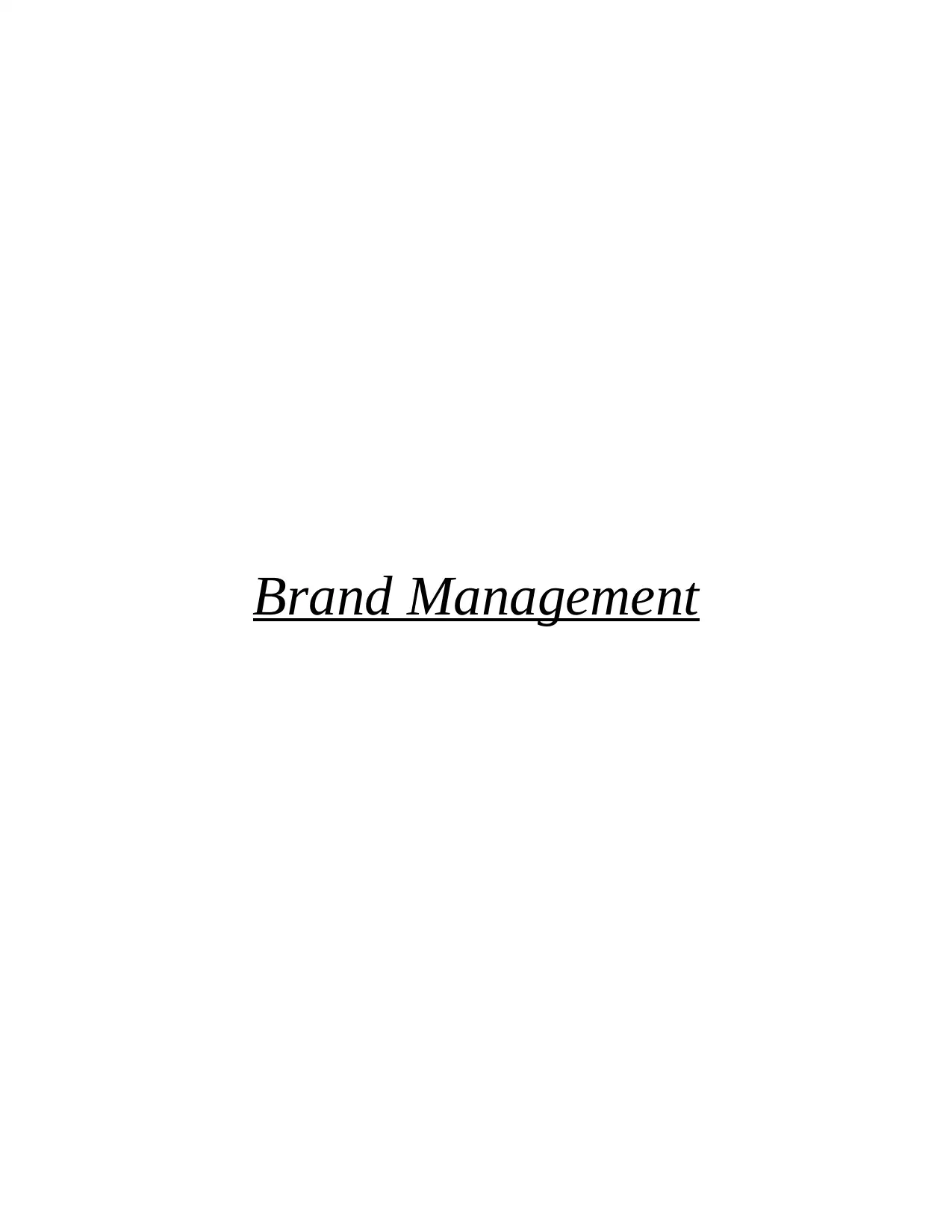
Brand Management
Paraphrase This Document
Need a fresh take? Get an instant paraphrase of this document with our AI Paraphraser
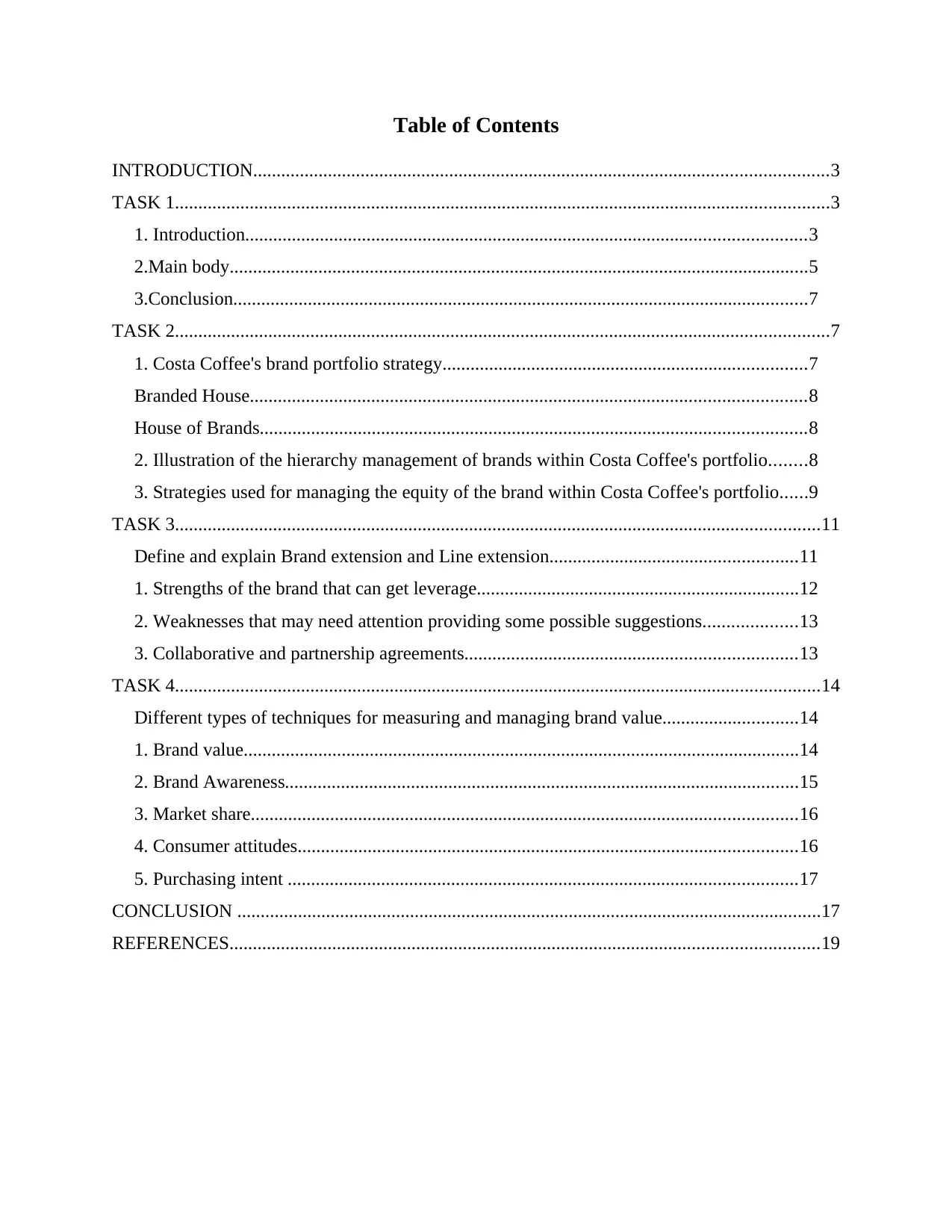
Table of Contents
INTRODUCTION...........................................................................................................................3
TASK 1............................................................................................................................................3
1. Introduction........................................................................................................................3
2.Main body............................................................................................................................5
3.Conclusion...........................................................................................................................7
TASK 2............................................................................................................................................7
1. Costa Coffee's brand portfolio strategy..............................................................................7
Branded House.......................................................................................................................8
House of Brands.....................................................................................................................8
2. Illustration of the hierarchy management of brands within Costa Coffee's portfolio........8
3. Strategies used for managing the equity of the brand within Costa Coffee's portfolio......9
TASK 3..........................................................................................................................................11
Define and explain Brand extension and Line extension.....................................................11
1. Strengths of the brand that can get leverage.....................................................................12
2. Weaknesses that may need attention providing some possible suggestions....................13
3. Collaborative and partnership agreements.......................................................................13
TASK 4..........................................................................................................................................14
Different types of techniques for measuring and managing brand value.............................14
1. Brand value.......................................................................................................................14
2. Brand Awareness..............................................................................................................15
3. Market share.....................................................................................................................16
4. Consumer attitudes...........................................................................................................16
5. Purchasing intent .............................................................................................................17
CONCLUSION .............................................................................................................................17
REFERENCES..............................................................................................................................19
INTRODUCTION...........................................................................................................................3
TASK 1............................................................................................................................................3
1. Introduction........................................................................................................................3
2.Main body............................................................................................................................5
3.Conclusion...........................................................................................................................7
TASK 2............................................................................................................................................7
1. Costa Coffee's brand portfolio strategy..............................................................................7
Branded House.......................................................................................................................8
House of Brands.....................................................................................................................8
2. Illustration of the hierarchy management of brands within Costa Coffee's portfolio........8
3. Strategies used for managing the equity of the brand within Costa Coffee's portfolio......9
TASK 3..........................................................................................................................................11
Define and explain Brand extension and Line extension.....................................................11
1. Strengths of the brand that can get leverage.....................................................................12
2. Weaknesses that may need attention providing some possible suggestions....................13
3. Collaborative and partnership agreements.......................................................................13
TASK 4..........................................................................................................................................14
Different types of techniques for measuring and managing brand value.............................14
1. Brand value.......................................................................................................................14
2. Brand Awareness..............................................................................................................15
3. Market share.....................................................................................................................16
4. Consumer attitudes...........................................................................................................16
5. Purchasing intent .............................................................................................................17
CONCLUSION .............................................................................................................................17
REFERENCES..............................................................................................................................19
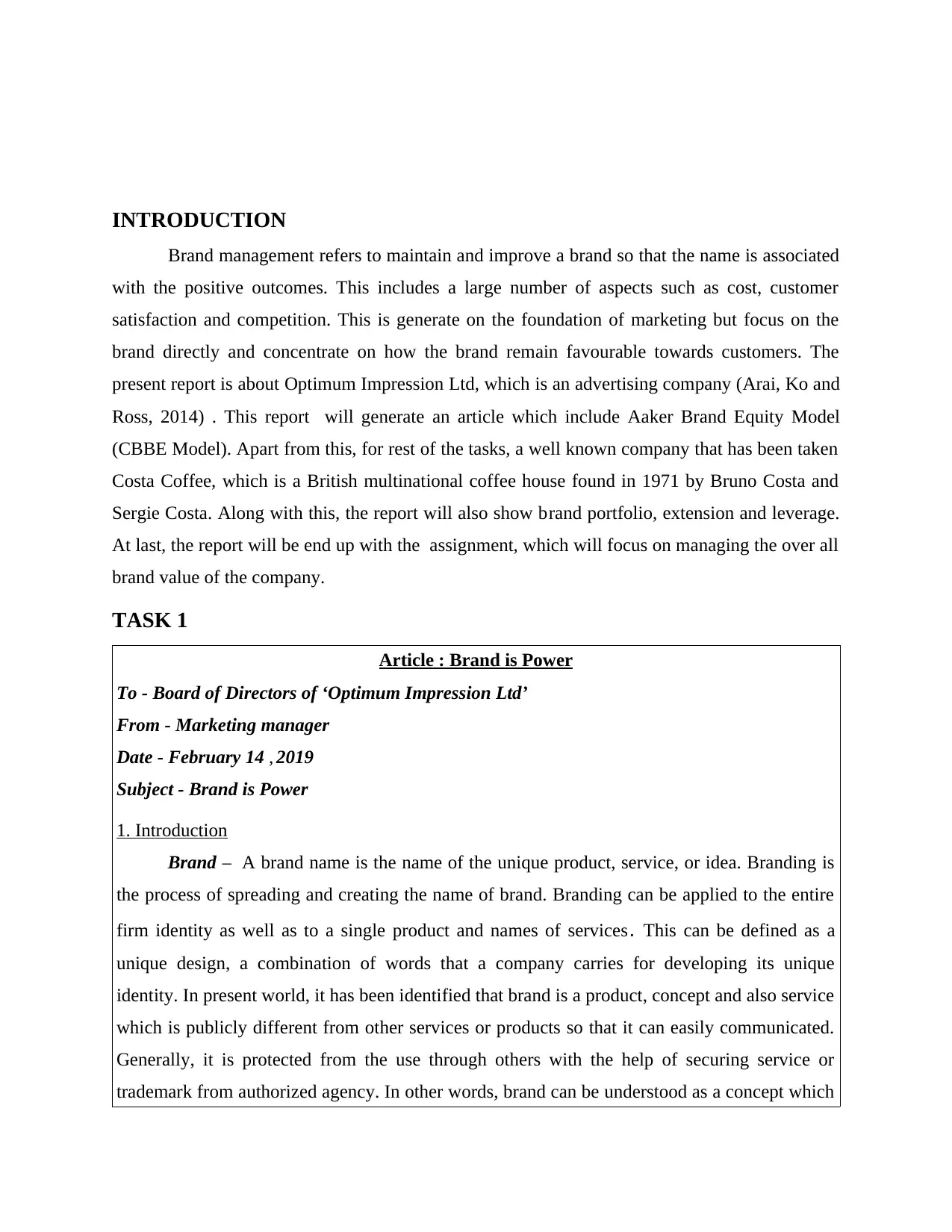
INTRODUCTION
Brand management refers to maintain and improve a brand so that the name is associated
with the positive outcomes. This includes a large number of aspects such as cost, customer
satisfaction and competition. This is generate on the foundation of marketing but focus on the
brand directly and concentrate on how the brand remain favourable towards customers. The
present report is about Optimum Impression Ltd, which is an advertising company (Arai, Ko and
Ross, 2014) . This report will generate an article which include Aaker Brand Equity Model
(CBBE Model). Apart from this, for rest of the tasks, a well known company that has been taken
Costa Coffee, which is a British multinational coffee house found in 1971 by Bruno Costa and
Sergie Costa. Along with this, the report will also show brand portfolio, extension and leverage.
At last, the report will be end up with the assignment, which will focus on managing the over all
brand value of the company.
TASK 1
Article : Brand is Power
To - Board of Directors of ‘Optimum Impression Ltd’
From - Marketing manager
Date - February 14 , 2019
Subject - Brand is Power
1. Introduction
Brand – A brand name is the name of the unique product, service, or idea. Branding is
the process of spreading and creating the name of brand. Branding can be applied to the entire
firm identity as well as to a single product and names of services. This can be defined as a
unique design, a combination of words that a company carries for developing its unique
identity. In present world, it has been identified that brand is a product, concept and also service
which is publicly different from other services or products so that it can easily communicated.
Generally, it is protected from the use through others with the help of securing service or
trademark from authorized agency. In other words, brand can be understood as a concept which
Brand management refers to maintain and improve a brand so that the name is associated
with the positive outcomes. This includes a large number of aspects such as cost, customer
satisfaction and competition. This is generate on the foundation of marketing but focus on the
brand directly and concentrate on how the brand remain favourable towards customers. The
present report is about Optimum Impression Ltd, which is an advertising company (Arai, Ko and
Ross, 2014) . This report will generate an article which include Aaker Brand Equity Model
(CBBE Model). Apart from this, for rest of the tasks, a well known company that has been taken
Costa Coffee, which is a British multinational coffee house found in 1971 by Bruno Costa and
Sergie Costa. Along with this, the report will also show brand portfolio, extension and leverage.
At last, the report will be end up with the assignment, which will focus on managing the over all
brand value of the company.
TASK 1
Article : Brand is Power
To - Board of Directors of ‘Optimum Impression Ltd’
From - Marketing manager
Date - February 14 , 2019
Subject - Brand is Power
1. Introduction
Brand – A brand name is the name of the unique product, service, or idea. Branding is
the process of spreading and creating the name of brand. Branding can be applied to the entire
firm identity as well as to a single product and names of services. This can be defined as a
unique design, a combination of words that a company carries for developing its unique
identity. In present world, it has been identified that brand is a product, concept and also service
which is publicly different from other services or products so that it can easily communicated.
Generally, it is protected from the use through others with the help of securing service or
trademark from authorized agency. In other words, brand can be understood as a concept which
⊘ This is a preview!⊘
Do you want full access?
Subscribe today to unlock all pages.

Trusted by 1+ million students worldwide
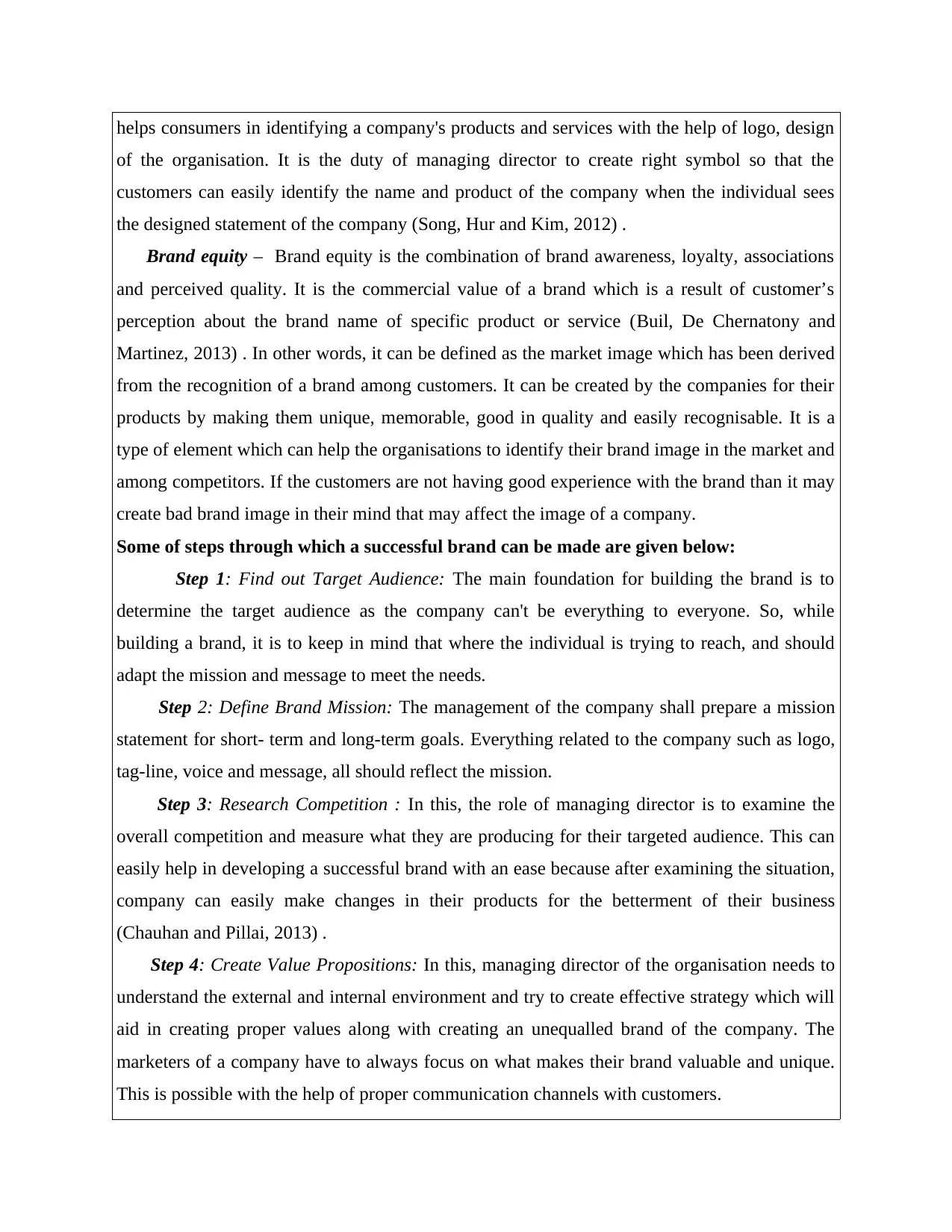
helps consumers in identifying a company's products and services with the help of logo, design
of the organisation. It is the duty of managing director to create right symbol so that the
customers can easily identify the name and product of the company when the individual sees
the designed statement of the company (Song, Hur and Kim, 2012) .
Brand equity – Brand equity is the combination of brand awareness, loyalty, associations
and perceived quality. It is the commercial value of a brand which is a result of customer’s
perception about the brand name of specific product or service (Buil, De Chernatony and
Martinez, 2013) . In other words, it can be defined as the market image which has been derived
from the recognition of a brand among customers. It can be created by the companies for their
products by making them unique, memorable, good in quality and easily recognisable. It is a
type of element which can help the organisations to identify their brand image in the market and
among competitors. If the customers are not having good experience with the brand than it may
create bad brand image in their mind that may affect the image of a company.
Some of steps through which a successful brand can be made are given below:
Step 1: Find out Target Audience: The main foundation for building the brand is to
determine the target audience as the company can't be everything to everyone. So, while
building a brand, it is to keep in mind that where the individual is trying to reach, and should
adapt the mission and message to meet the needs.
Step 2: Define Brand Mission: The management of the company shall prepare a mission
statement for short- term and long-term goals. Everything related to the company such as logo,
tag-line, voice and message, all should reflect the mission.
Step 3: Research Competition : In this, the role of managing director is to examine the
overall competition and measure what they are producing for their targeted audience. This can
easily help in developing a successful brand with an ease because after examining the situation,
company can easily make changes in their products for the betterment of their business
(Chauhan and Pillai, 2013) .
Step 4: Create Value Propositions: In this, managing director of the organisation needs to
understand the external and internal environment and try to create effective strategy which will
aid in creating proper values along with creating an unequalled brand of the company. The
marketers of a company have to always focus on what makes their brand valuable and unique.
This is possible with the help of proper communication channels with customers.
of the organisation. It is the duty of managing director to create right symbol so that the
customers can easily identify the name and product of the company when the individual sees
the designed statement of the company (Song, Hur and Kim, 2012) .
Brand equity – Brand equity is the combination of brand awareness, loyalty, associations
and perceived quality. It is the commercial value of a brand which is a result of customer’s
perception about the brand name of specific product or service (Buil, De Chernatony and
Martinez, 2013) . In other words, it can be defined as the market image which has been derived
from the recognition of a brand among customers. It can be created by the companies for their
products by making them unique, memorable, good in quality and easily recognisable. It is a
type of element which can help the organisations to identify their brand image in the market and
among competitors. If the customers are not having good experience with the brand than it may
create bad brand image in their mind that may affect the image of a company.
Some of steps through which a successful brand can be made are given below:
Step 1: Find out Target Audience: The main foundation for building the brand is to
determine the target audience as the company can't be everything to everyone. So, while
building a brand, it is to keep in mind that where the individual is trying to reach, and should
adapt the mission and message to meet the needs.
Step 2: Define Brand Mission: The management of the company shall prepare a mission
statement for short- term and long-term goals. Everything related to the company such as logo,
tag-line, voice and message, all should reflect the mission.
Step 3: Research Competition : In this, the role of managing director is to examine the
overall competition and measure what they are producing for their targeted audience. This can
easily help in developing a successful brand with an ease because after examining the situation,
company can easily make changes in their products for the betterment of their business
(Chauhan and Pillai, 2013) .
Step 4: Create Value Propositions: In this, managing director of the organisation needs to
understand the external and internal environment and try to create effective strategy which will
aid in creating proper values along with creating an unequalled brand of the company. The
marketers of a company have to always focus on what makes their brand valuable and unique.
This is possible with the help of proper communication channels with customers.
Paraphrase This Document
Need a fresh take? Get an instant paraphrase of this document with our AI Paraphraser
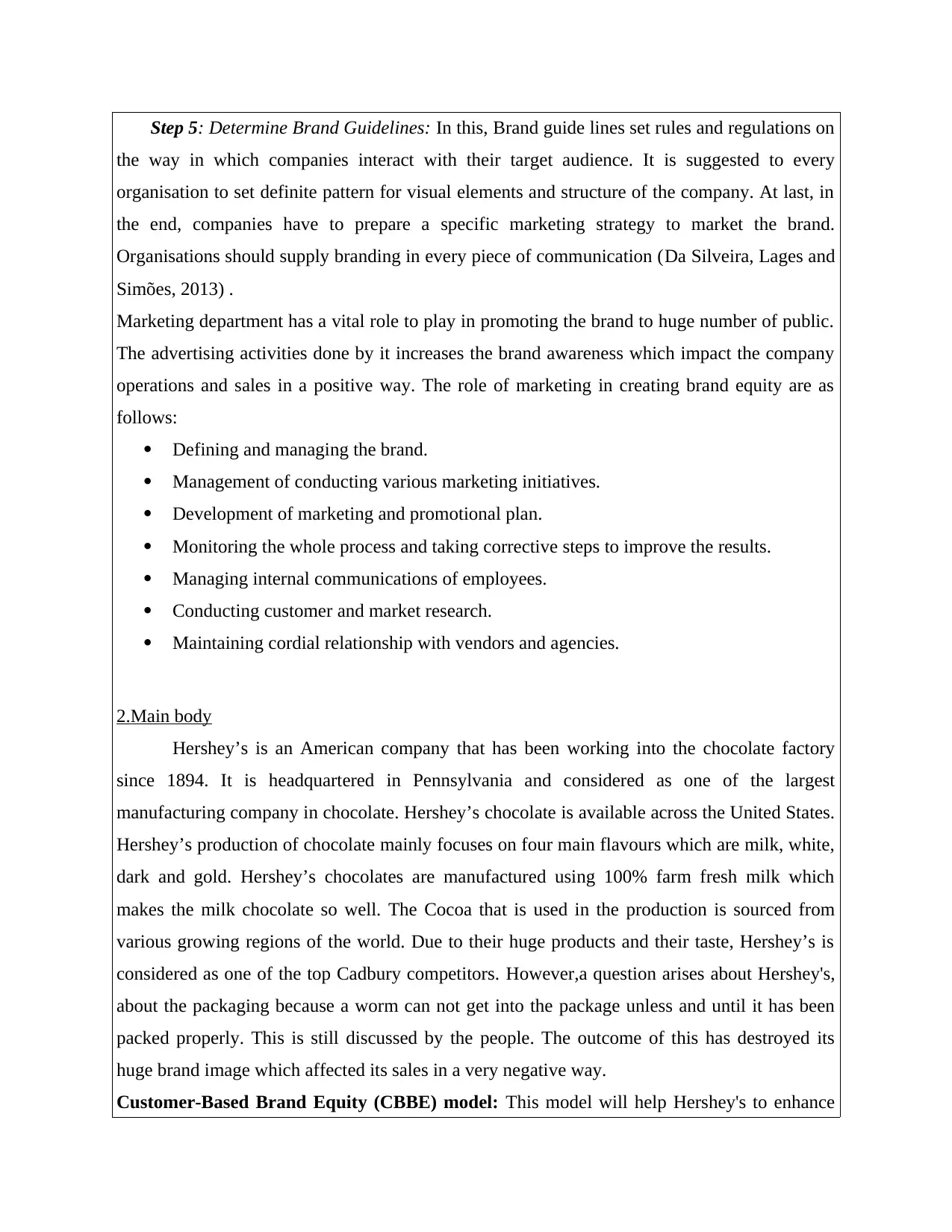
Step 5: Determine Brand Guidelines: In this, Brand guide lines set rules and regulations on
the way in which companies interact with their target audience. It is suggested to every
organisation to set definite pattern for visual elements and structure of the company. At last, in
the end, companies have to prepare a specific marketing strategy to market the brand.
Organisations should supply branding in every piece of communication (Da Silveira, Lages and
Simões, 2013) .
Marketing department has a vital role to play in promoting the brand to huge number of public.
The advertising activities done by it increases the brand awareness which impact the company
operations and sales in a positive way. The role of marketing in creating brand equity are as
follows:
Defining and managing the brand.
Management of conducting various marketing initiatives.
Development of marketing and promotional plan.
Monitoring the whole process and taking corrective steps to improve the results.
Managing internal communications of employees.
Conducting customer and market research.
Maintaining cordial relationship with vendors and agencies.
2.Main body
Hershey’s is an American company that has been working into the chocolate factory
since 1894. It is headquartered in Pennsylvania and considered as one of the largest
manufacturing company in chocolate. Hershey’s chocolate is available across the United States.
Hershey’s production of chocolate mainly focuses on four main flavours which are milk, white,
dark and gold. Hershey’s chocolates are manufactured using 100% farm fresh milk which
makes the milk chocolate so well. The Cocoa that is used in the production is sourced from
various growing regions of the world. Due to their huge products and their taste, Hershey’s is
considered as one of the top Cadbury competitors. However,a question arises about Hershey's,
about the packaging because a worm can not get into the package unless and until it has been
packed properly. This is still discussed by the people. The outcome of this has destroyed its
huge brand image which affected its sales in a very negative way.
Customer-Based Brand Equity (CBBE) model: This model will help Hershey's to enhance
the way in which companies interact with their target audience. It is suggested to every
organisation to set definite pattern for visual elements and structure of the company. At last, in
the end, companies have to prepare a specific marketing strategy to market the brand.
Organisations should supply branding in every piece of communication (Da Silveira, Lages and
Simões, 2013) .
Marketing department has a vital role to play in promoting the brand to huge number of public.
The advertising activities done by it increases the brand awareness which impact the company
operations and sales in a positive way. The role of marketing in creating brand equity are as
follows:
Defining and managing the brand.
Management of conducting various marketing initiatives.
Development of marketing and promotional plan.
Monitoring the whole process and taking corrective steps to improve the results.
Managing internal communications of employees.
Conducting customer and market research.
Maintaining cordial relationship with vendors and agencies.
2.Main body
Hershey’s is an American company that has been working into the chocolate factory
since 1894. It is headquartered in Pennsylvania and considered as one of the largest
manufacturing company in chocolate. Hershey’s chocolate is available across the United States.
Hershey’s production of chocolate mainly focuses on four main flavours which are milk, white,
dark and gold. Hershey’s chocolates are manufactured using 100% farm fresh milk which
makes the milk chocolate so well. The Cocoa that is used in the production is sourced from
various growing regions of the world. Due to their huge products and their taste, Hershey’s is
considered as one of the top Cadbury competitors. However,a question arises about Hershey's,
about the packaging because a worm can not get into the package unless and until it has been
packed properly. This is still discussed by the people. The outcome of this has destroyed its
huge brand image which affected its sales in a very negative way.
Customer-Based Brand Equity (CBBE) model: This model will help Hershey's to enhance
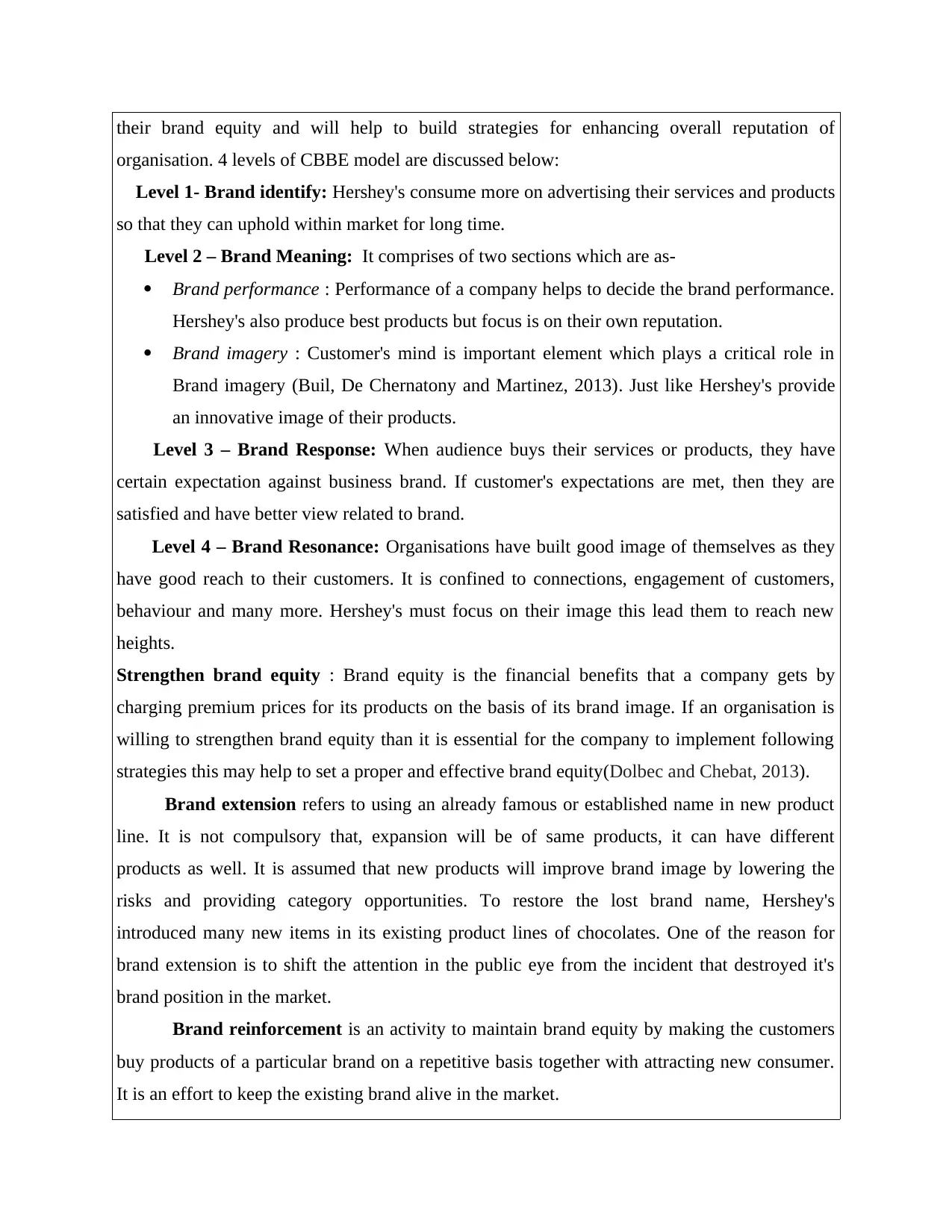
their brand equity and will help to build strategies for enhancing overall reputation of
organisation. 4 levels of CBBE model are discussed below:
Level 1- Brand identify: Hershey's consume more on advertising their services and products
so that they can uphold within market for long time.
Level 2 – Brand Meaning: It comprises of two sections which are as-
Brand performance : Performance of a company helps to decide the brand performance.
Hershey's also produce best products but focus is on their own reputation.
Brand imagery : Customer's mind is important element which plays a critical role in
Brand imagery (Buil, De Chernatony and Martinez, 2013). Just like Hershey's provide
an innovative image of their products.
Level 3 – Brand Response: When audience buys their services or products, they have
certain expectation against business brand. If customer's expectations are met, then they are
satisfied and have better view related to brand.
Level 4 – Brand Resonance: Organisations have built good image of themselves as they
have good reach to their customers. It is confined to connections, engagement of customers,
behaviour and many more. Hershey's must focus on their image this lead them to reach new
heights.
Strengthen brand equity : Brand equity is the financial benefits that a company gets by
charging premium prices for its products on the basis of its brand image. If an organisation is
willing to strengthen brand equity than it is essential for the company to implement following
strategies this may help to set a proper and effective brand equity(Dolbec and Chebat, 2013).
Brand extension refers to using an already famous or established name in new product
line. It is not compulsory that, expansion will be of same products, it can have different
products as well. It is assumed that new products will improve brand image by lowering the
risks and providing category opportunities. To restore the lost brand name, Hershey's
introduced many new items in its existing product lines of chocolates. One of the reason for
brand extension is to shift the attention in the public eye from the incident that destroyed it's
brand position in the market.
Brand reinforcement is an activity to maintain brand equity by making the customers
buy products of a particular brand on a repetitive basis together with attracting new consumer.
It is an effort to keep the existing brand alive in the market.
organisation. 4 levels of CBBE model are discussed below:
Level 1- Brand identify: Hershey's consume more on advertising their services and products
so that they can uphold within market for long time.
Level 2 – Brand Meaning: It comprises of two sections which are as-
Brand performance : Performance of a company helps to decide the brand performance.
Hershey's also produce best products but focus is on their own reputation.
Brand imagery : Customer's mind is important element which plays a critical role in
Brand imagery (Buil, De Chernatony and Martinez, 2013). Just like Hershey's provide
an innovative image of their products.
Level 3 – Brand Response: When audience buys their services or products, they have
certain expectation against business brand. If customer's expectations are met, then they are
satisfied and have better view related to brand.
Level 4 – Brand Resonance: Organisations have built good image of themselves as they
have good reach to their customers. It is confined to connections, engagement of customers,
behaviour and many more. Hershey's must focus on their image this lead them to reach new
heights.
Strengthen brand equity : Brand equity is the financial benefits that a company gets by
charging premium prices for its products on the basis of its brand image. If an organisation is
willing to strengthen brand equity than it is essential for the company to implement following
strategies this may help to set a proper and effective brand equity(Dolbec and Chebat, 2013).
Brand extension refers to using an already famous or established name in new product
line. It is not compulsory that, expansion will be of same products, it can have different
products as well. It is assumed that new products will improve brand image by lowering the
risks and providing category opportunities. To restore the lost brand name, Hershey's
introduced many new items in its existing product lines of chocolates. One of the reason for
brand extension is to shift the attention in the public eye from the incident that destroyed it's
brand position in the market.
Brand reinforcement is an activity to maintain brand equity by making the customers
buy products of a particular brand on a repetitive basis together with attracting new consumer.
It is an effort to keep the existing brand alive in the market.
⊘ This is a preview!⊘
Do you want full access?
Subscribe today to unlock all pages.

Trusted by 1+ million students worldwide
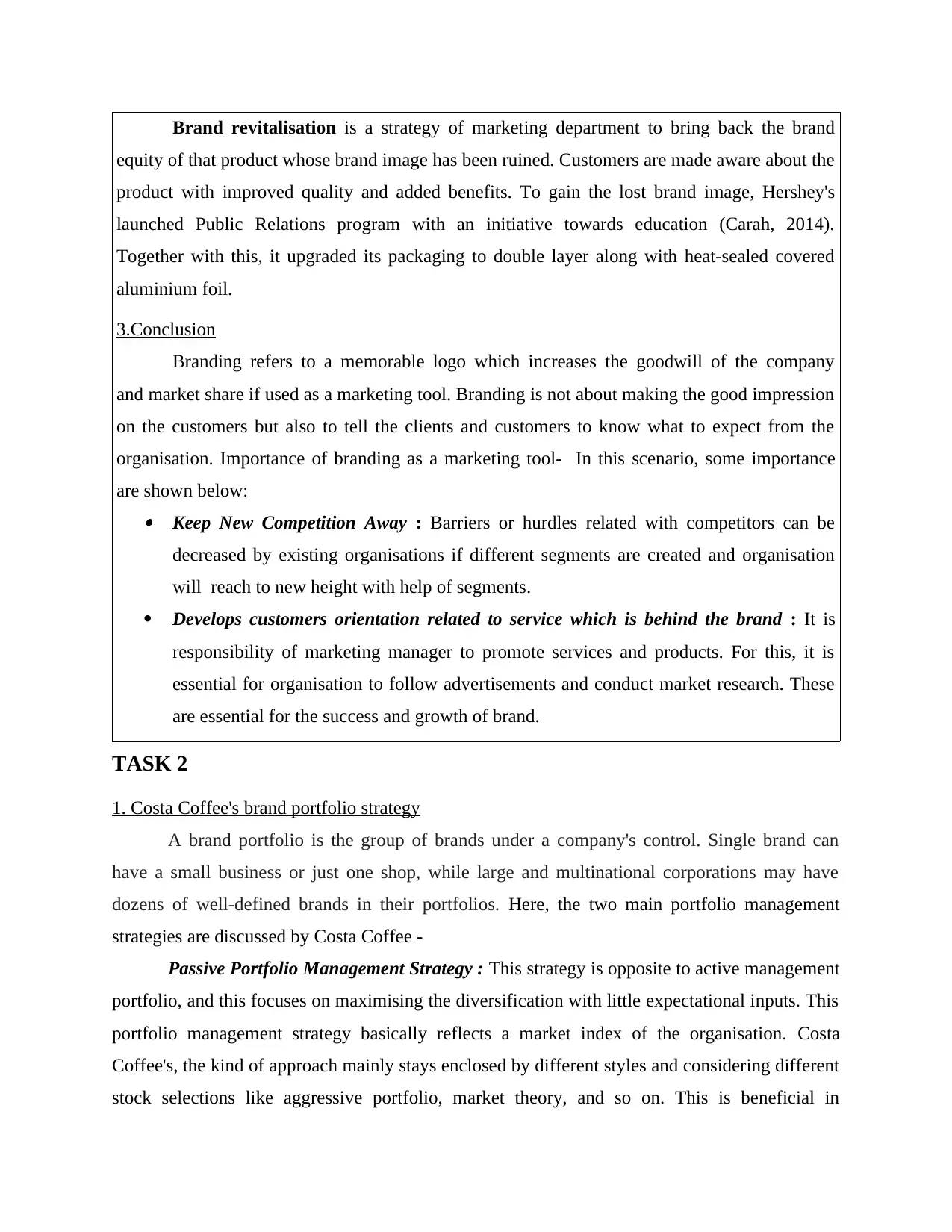
Brand revitalisation is a strategy of marketing department to bring back the brand
equity of that product whose brand image has been ruined. Customers are made aware about the
product with improved quality and added benefits. To gain the lost brand image, Hershey's
launched Public Relations program with an initiative towards education (Carah, 2014).
Together with this, it upgraded its packaging to double layer along with heat-sealed covered
aluminium foil.
3.Conclusion
Branding refers to a memorable logo which increases the goodwill of the company
and market share if used as a marketing tool. Branding is not about making the good impression
on the customers but also to tell the clients and customers to know what to expect from the
organisation. Importance of branding as a marketing tool- In this scenario, some importance
are shown below: Keep New Competition Away : Barriers or hurdles related with competitors can be
decreased by existing organisations if different segments are created and organisation
will reach to new height with help of segments.
Develops customers orientation related to service which is behind the brand : It is
responsibility of marketing manager to promote services and products. For this, it is
essential for organisation to follow advertisements and conduct market research. These
are essential for the success and growth of brand.
TASK 2
1. Costa Coffee's brand portfolio strategy
A brand portfolio is the group of brands under a company's control. Single brand can
have a small business or just one shop, while large and multinational corporations may have
dozens of well-defined brands in their portfolios. Here, the two main portfolio management
strategies are discussed by Costa Coffee -
Passive Portfolio Management Strategy : This strategy is opposite to active management
portfolio, and this focuses on maximising the diversification with little expectational inputs. This
portfolio management strategy basically reflects a market index of the organisation. Costa
Coffee's, the kind of approach mainly stays enclosed by different styles and considering different
stock selections like aggressive portfolio, market theory, and so on. This is beneficial in
equity of that product whose brand image has been ruined. Customers are made aware about the
product with improved quality and added benefits. To gain the lost brand image, Hershey's
launched Public Relations program with an initiative towards education (Carah, 2014).
Together with this, it upgraded its packaging to double layer along with heat-sealed covered
aluminium foil.
3.Conclusion
Branding refers to a memorable logo which increases the goodwill of the company
and market share if used as a marketing tool. Branding is not about making the good impression
on the customers but also to tell the clients and customers to know what to expect from the
organisation. Importance of branding as a marketing tool- In this scenario, some importance
are shown below: Keep New Competition Away : Barriers or hurdles related with competitors can be
decreased by existing organisations if different segments are created and organisation
will reach to new height with help of segments.
Develops customers orientation related to service which is behind the brand : It is
responsibility of marketing manager to promote services and products. For this, it is
essential for organisation to follow advertisements and conduct market research. These
are essential for the success and growth of brand.
TASK 2
1. Costa Coffee's brand portfolio strategy
A brand portfolio is the group of brands under a company's control. Single brand can
have a small business or just one shop, while large and multinational corporations may have
dozens of well-defined brands in their portfolios. Here, the two main portfolio management
strategies are discussed by Costa Coffee -
Passive Portfolio Management Strategy : This strategy is opposite to active management
portfolio, and this focuses on maximising the diversification with little expectational inputs. This
portfolio management strategy basically reflects a market index of the organisation. Costa
Coffee's, the kind of approach mainly stays enclosed by different styles and considering different
stock selections like aggressive portfolio, market theory, and so on. This is beneficial in
Paraphrase This Document
Need a fresh take? Get an instant paraphrase of this document with our AI Paraphraser
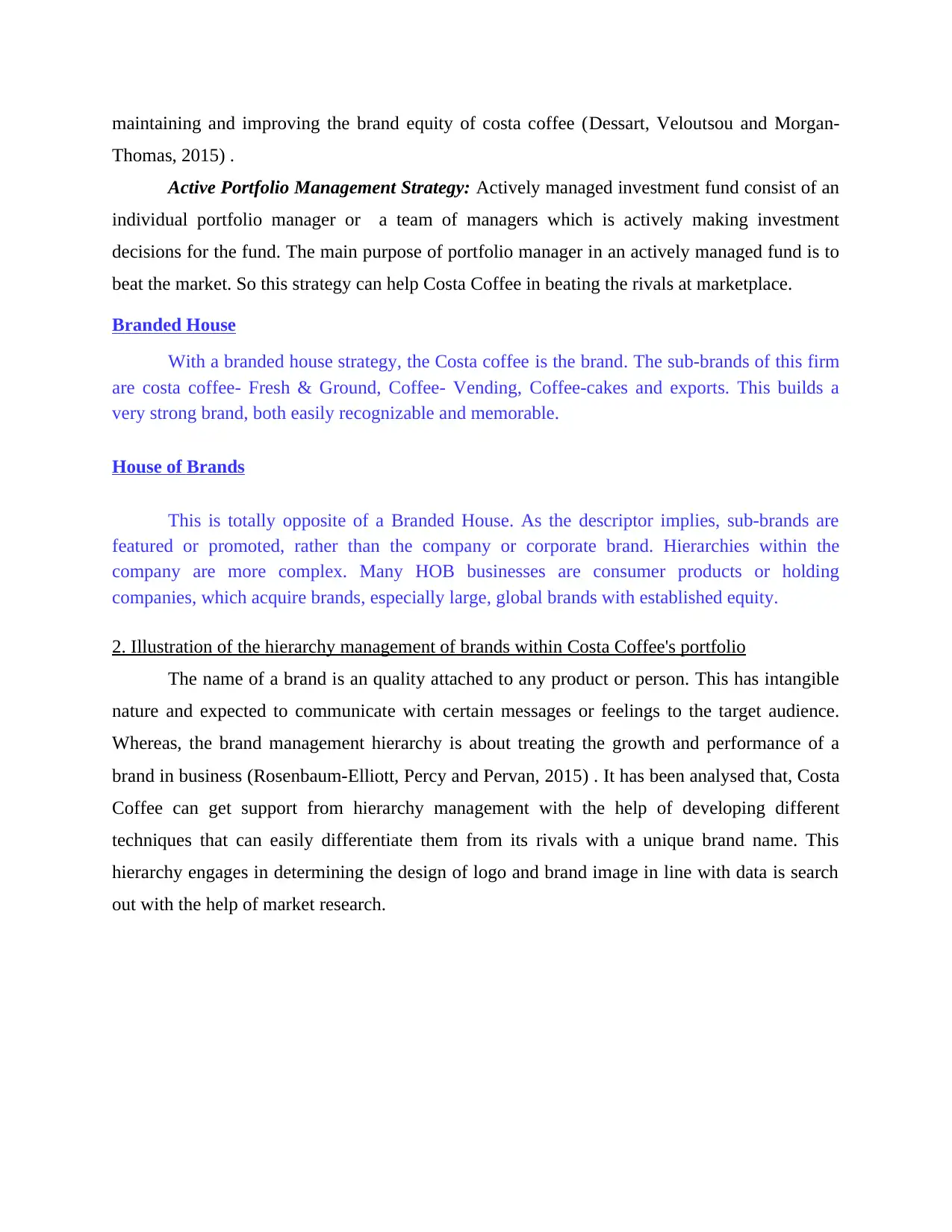
maintaining and improving the brand equity of costa coffee (Dessart, Veloutsou and Morgan-
Thomas, 2015) .
Active Portfolio Management Strategy: Actively managed investment fund consist of an
individual portfolio manager or a team of managers which is actively making investment
decisions for the fund. The main purpose of portfolio manager in an actively managed fund is to
beat the market. So this strategy can help Costa Coffee in beating the rivals at marketplace.
Branded House
With a branded house strategy, the Costa coffee is the brand. The sub-brands of this firm
are costa coffee- Fresh & Ground, Coffee- Vending, Coffee-cakes and exports. This builds a
very strong brand, both easily recognizable and memorable.
House of Brands
This is totally opposite of a Branded House. As the descriptor implies, sub-brands are
featured or promoted, rather than the company or corporate brand. Hierarchies within the
company are more complex. Many HOB businesses are consumer products or holding
companies, which acquire brands, especially large, global brands with established equity.
2. Illustration of the hierarchy management of brands within Costa Coffee's portfolio
The name of a brand is an quality attached to any product or person. This has intangible
nature and expected to communicate with certain messages or feelings to the target audience.
Whereas, the brand management hierarchy is about treating the growth and performance of a
brand in business (Rosenbaum-Elliott, Percy and Pervan, 2015) . It has been analysed that, Costa
Coffee can get support from hierarchy management with the help of developing different
techniques that can easily differentiate them from its rivals with a unique brand name. This
hierarchy engages in determining the design of logo and brand image in line with data is search
out with the help of market research.
Thomas, 2015) .
Active Portfolio Management Strategy: Actively managed investment fund consist of an
individual portfolio manager or a team of managers which is actively making investment
decisions for the fund. The main purpose of portfolio manager in an actively managed fund is to
beat the market. So this strategy can help Costa Coffee in beating the rivals at marketplace.
Branded House
With a branded house strategy, the Costa coffee is the brand. The sub-brands of this firm
are costa coffee- Fresh & Ground, Coffee- Vending, Coffee-cakes and exports. This builds a
very strong brand, both easily recognizable and memorable.
House of Brands
This is totally opposite of a Branded House. As the descriptor implies, sub-brands are
featured or promoted, rather than the company or corporate brand. Hierarchies within the
company are more complex. Many HOB businesses are consumer products or holding
companies, which acquire brands, especially large, global brands with established equity.
2. Illustration of the hierarchy management of brands within Costa Coffee's portfolio
The name of a brand is an quality attached to any product or person. This has intangible
nature and expected to communicate with certain messages or feelings to the target audience.
Whereas, the brand management hierarchy is about treating the growth and performance of a
brand in business (Rosenbaum-Elliott, Percy and Pervan, 2015) . It has been analysed that, Costa
Coffee can get support from hierarchy management with the help of developing different
techniques that can easily differentiate them from its rivals with a unique brand name. This
hierarchy engages in determining the design of logo and brand image in line with data is search
out with the help of market research.
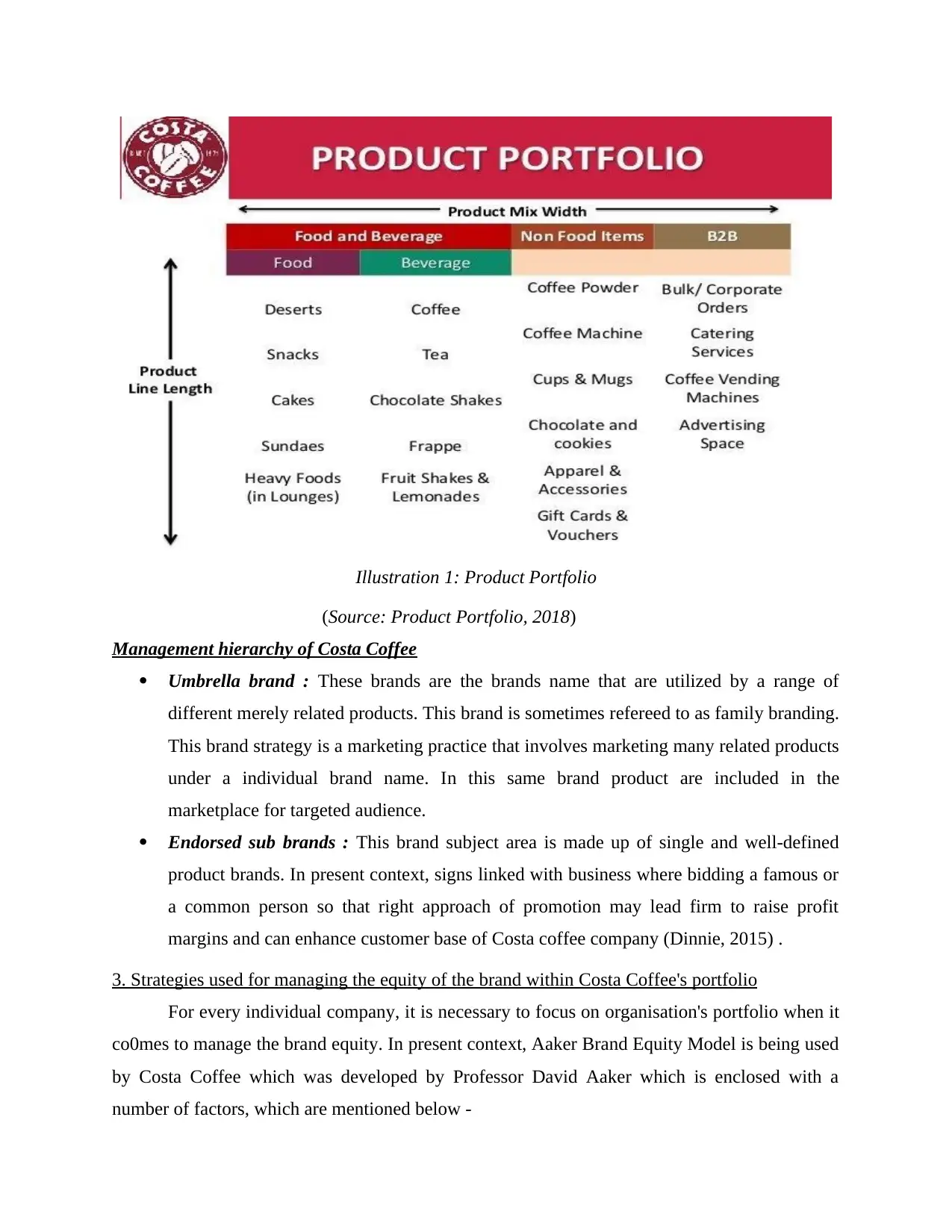
(Source: Product Portfolio, 2018)
Management hierarchy of Costa Coffee
Umbrella brand : These brands are the brands name that are utilized by a range of
different merely related products. This brand is sometimes refereed to as family branding.
This brand strategy is a marketing practice that involves marketing many related products
under a individual brand name. In this same brand product are included in the
marketplace for targeted audience.
Endorsed sub brands : This brand subject area is made up of single and well-defined
product brands. In present context, signs linked with business where bidding a famous or
a common person so that right approach of promotion may lead firm to raise profit
margins and can enhance customer base of Costa coffee company (Dinnie, 2015) .
3. Strategies used for managing the equity of the brand within Costa Coffee's portfolio
For every individual company, it is necessary to focus on organisation's portfolio when it
co0mes to manage the brand equity. In present context, Aaker Brand Equity Model is being used
by Costa Coffee which was developed by Professor David Aaker which is enclosed with a
number of factors, which are mentioned below -
Illustration 1: Product Portfolio
Management hierarchy of Costa Coffee
Umbrella brand : These brands are the brands name that are utilized by a range of
different merely related products. This brand is sometimes refereed to as family branding.
This brand strategy is a marketing practice that involves marketing many related products
under a individual brand name. In this same brand product are included in the
marketplace for targeted audience.
Endorsed sub brands : This brand subject area is made up of single and well-defined
product brands. In present context, signs linked with business where bidding a famous or
a common person so that right approach of promotion may lead firm to raise profit
margins and can enhance customer base of Costa coffee company (Dinnie, 2015) .
3. Strategies used for managing the equity of the brand within Costa Coffee's portfolio
For every individual company, it is necessary to focus on organisation's portfolio when it
co0mes to manage the brand equity. In present context, Aaker Brand Equity Model is being used
by Costa Coffee which was developed by Professor David Aaker which is enclosed with a
number of factors, which are mentioned below -
Illustration 1: Product Portfolio
⊘ This is a preview!⊘
Do you want full access?
Subscribe today to unlock all pages.

Trusted by 1+ million students worldwide
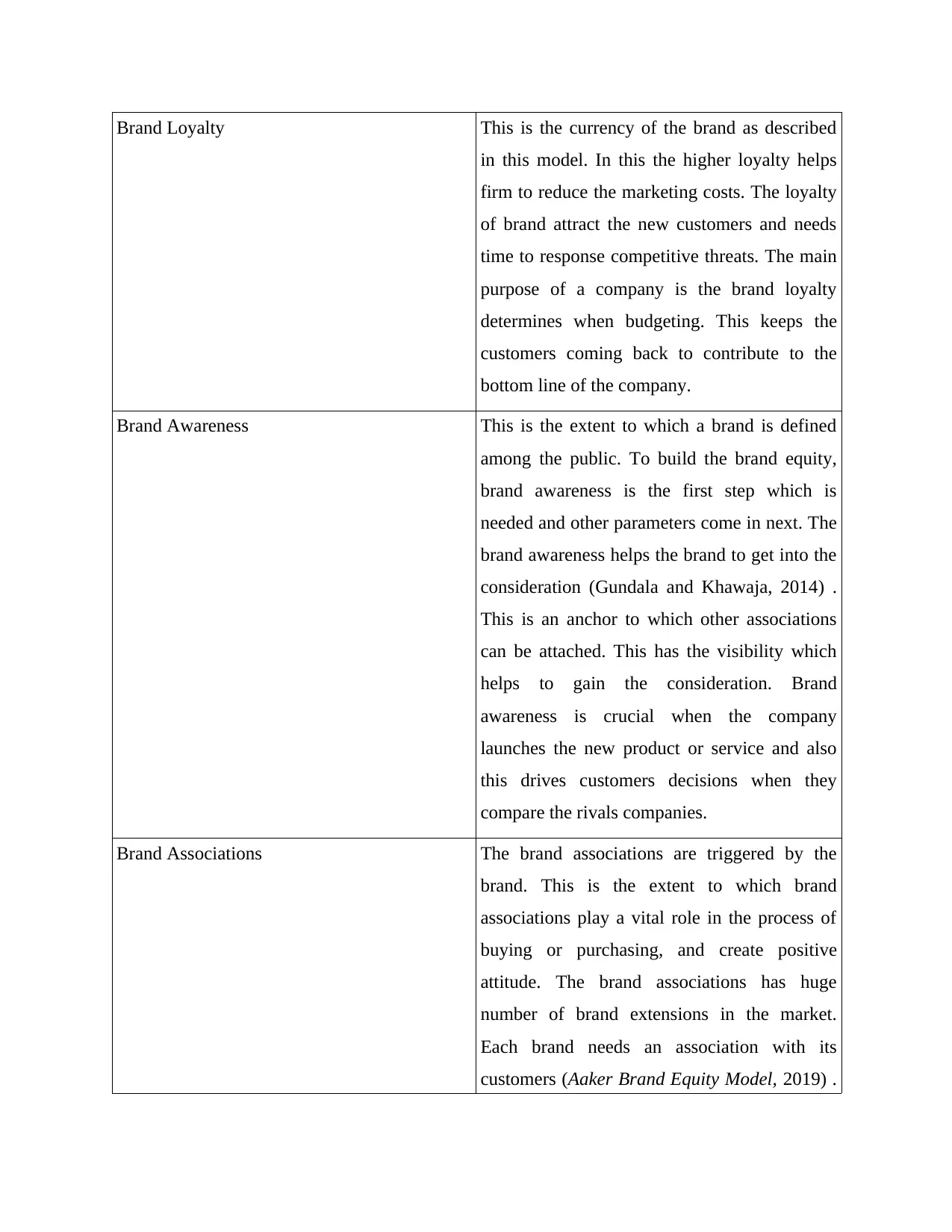
Brand Loyalty This is the currency of the brand as described
in this model. In this the higher loyalty helps
firm to reduce the marketing costs. The loyalty
of brand attract the new customers and needs
time to response competitive threats. The main
purpose of a company is the brand loyalty
determines when budgeting. This keeps the
customers coming back to contribute to the
bottom line of the company.
Brand Awareness This is the extent to which a brand is defined
among the public. To build the brand equity,
brand awareness is the first step which is
needed and other parameters come in next. The
brand awareness helps the brand to get into the
consideration (Gundala and Khawaja, 2014) .
This is an anchor to which other associations
can be attached. This has the visibility which
helps to gain the consideration. Brand
awareness is crucial when the company
launches the new product or service and also
this drives customers decisions when they
compare the rivals companies.
Brand Associations The brand associations are triggered by the
brand. This is the extent to which brand
associations play a vital role in the process of
buying or purchasing, and create positive
attitude. The brand associations has huge
number of brand extensions in the market.
Each brand needs an association with its
customers (Aaker Brand Equity Model, 2019) .
in this model. In this the higher loyalty helps
firm to reduce the marketing costs. The loyalty
of brand attract the new customers and needs
time to response competitive threats. The main
purpose of a company is the brand loyalty
determines when budgeting. This keeps the
customers coming back to contribute to the
bottom line of the company.
Brand Awareness This is the extent to which a brand is defined
among the public. To build the brand equity,
brand awareness is the first step which is
needed and other parameters come in next. The
brand awareness helps the brand to get into the
consideration (Gundala and Khawaja, 2014) .
This is an anchor to which other associations
can be attached. This has the visibility which
helps to gain the consideration. Brand
awareness is crucial when the company
launches the new product or service and also
this drives customers decisions when they
compare the rivals companies.
Brand Associations The brand associations are triggered by the
brand. This is the extent to which brand
associations play a vital role in the process of
buying or purchasing, and create positive
attitude. The brand associations has huge
number of brand extensions in the market.
Each brand needs an association with its
customers (Aaker Brand Equity Model, 2019) .
Paraphrase This Document
Need a fresh take? Get an instant paraphrase of this document with our AI Paraphraser
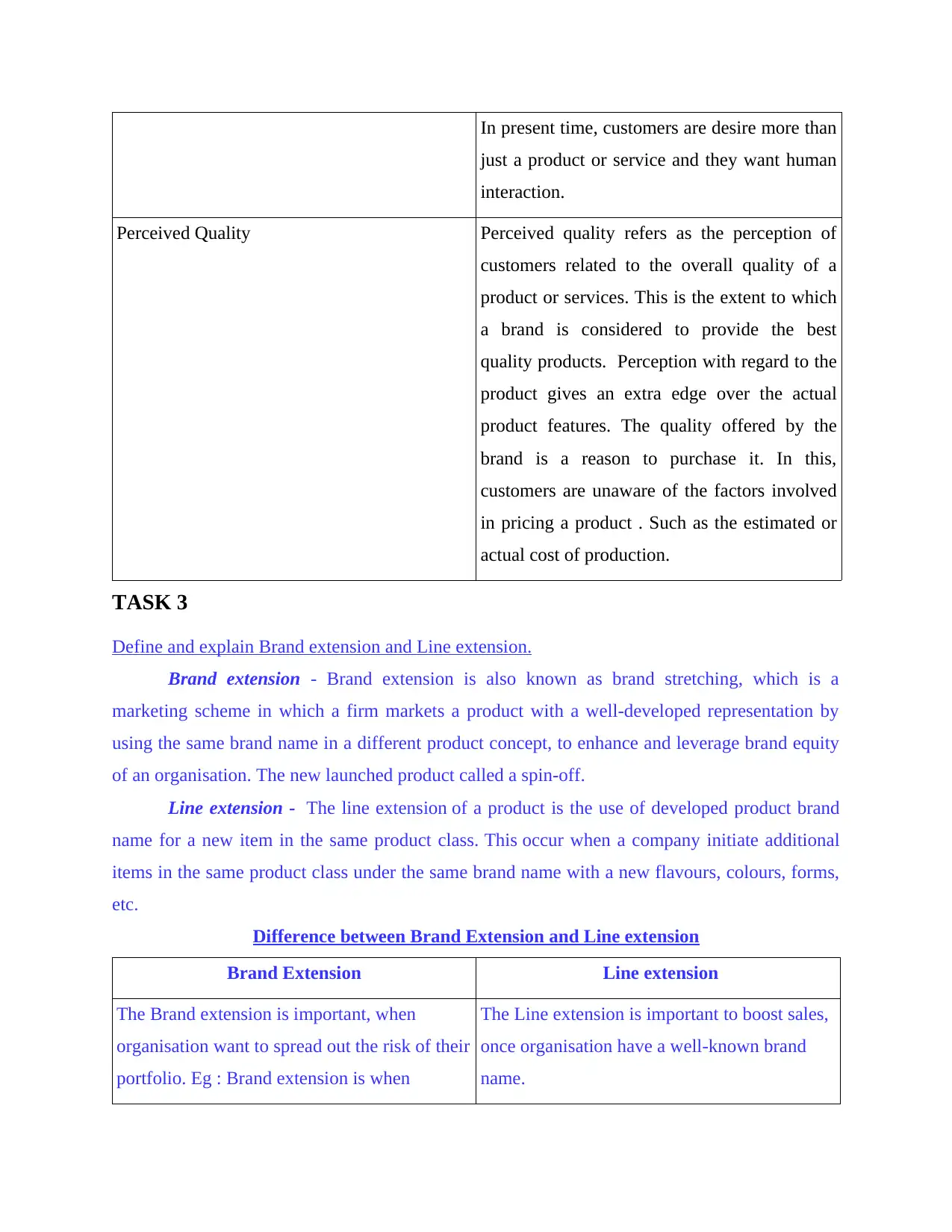
In present time, customers are desire more than
just a product or service and they want human
interaction.
Perceived Quality Perceived quality refers as the perception of
customers related to the overall quality of a
product or services. This is the extent to which
a brand is considered to provide the best
quality products. Perception with regard to the
product gives an extra edge over the actual
product features. The quality offered by the
brand is a reason to purchase it. In this,
customers are unaware of the factors involved
in pricing a product . Such as the estimated or
actual cost of production.
TASK 3
Define and explain Brand extension and Line extension.
Brand extension - Brand extension is also known as brand stretching, which is a
marketing scheme in which a firm markets a product with a well-developed representation by
using the same brand name in a different product concept, to enhance and leverage brand equity
of an organisation. The new launched product called a spin-off.
Line extension - The line extension of a product is the use of developed product brand
name for a new item in the same product class. This occur when a company initiate additional
items in the same product class under the same brand name with a new flavours, colours, forms,
etc.
Difference between Brand Extension and Line extension
Brand Extension Line extension
The Brand extension is important, when
organisation want to spread out the risk of their
portfolio. Eg : Brand extension is when
The Line extension is important to boost sales,
once organisation have a well-known brand
name.
just a product or service and they want human
interaction.
Perceived Quality Perceived quality refers as the perception of
customers related to the overall quality of a
product or services. This is the extent to which
a brand is considered to provide the best
quality products. Perception with regard to the
product gives an extra edge over the actual
product features. The quality offered by the
brand is a reason to purchase it. In this,
customers are unaware of the factors involved
in pricing a product . Such as the estimated or
actual cost of production.
TASK 3
Define and explain Brand extension and Line extension.
Brand extension - Brand extension is also known as brand stretching, which is a
marketing scheme in which a firm markets a product with a well-developed representation by
using the same brand name in a different product concept, to enhance and leverage brand equity
of an organisation. The new launched product called a spin-off.
Line extension - The line extension of a product is the use of developed product brand
name for a new item in the same product class. This occur when a company initiate additional
items in the same product class under the same brand name with a new flavours, colours, forms,
etc.
Difference between Brand Extension and Line extension
Brand Extension Line extension
The Brand extension is important, when
organisation want to spread out the risk of their
portfolio. Eg : Brand extension is when
The Line extension is important to boost sales,
once organisation have a well-known brand
name.
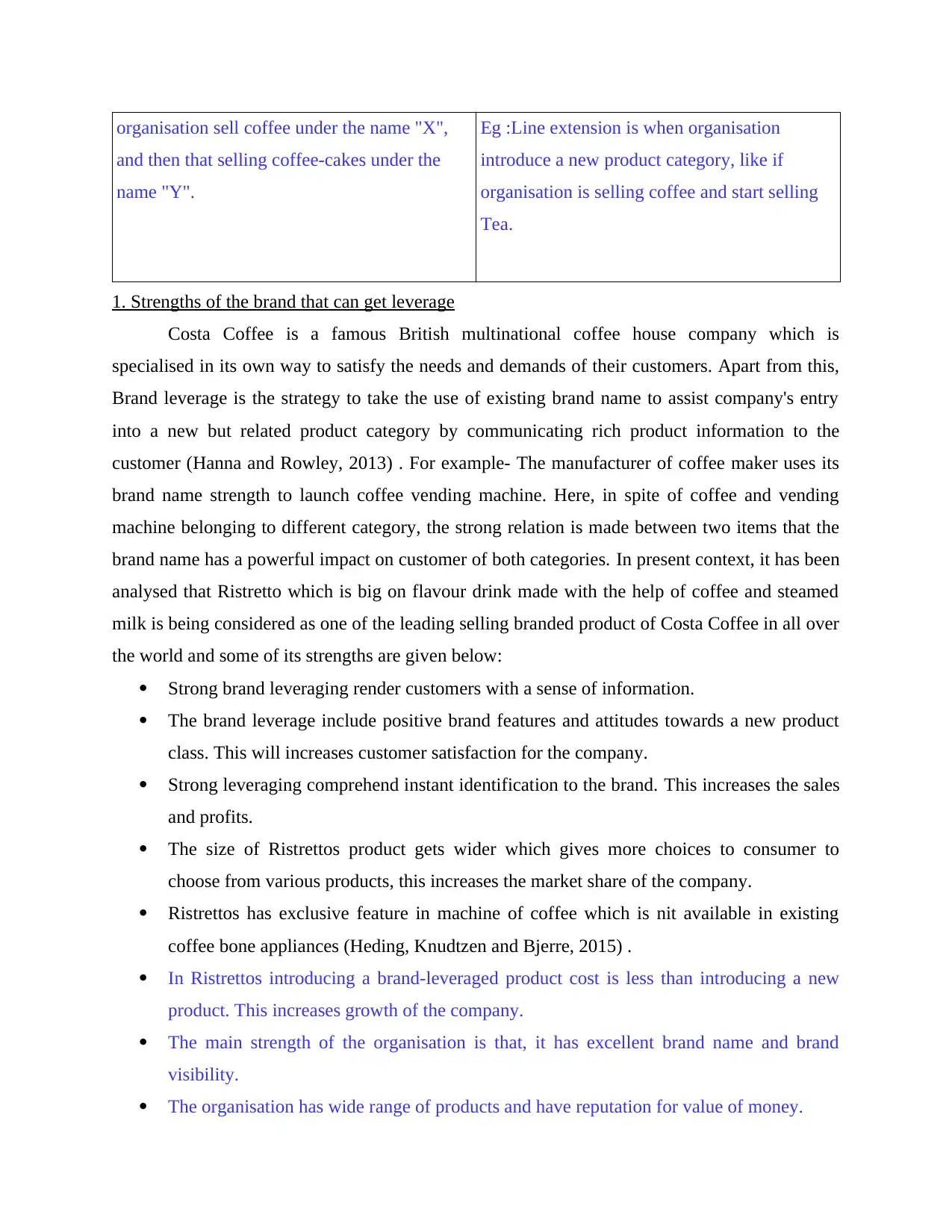
organisation sell coffee under the name "X",
and then that selling coffee-cakes under the
name "Y".
Eg :Line extension is when organisation
introduce a new product category, like if
organisation is selling coffee and start selling
Tea.
1. Strengths of the brand that can get leverage
Costa Coffee is a famous British multinational coffee house company which is
specialised in its own way to satisfy the needs and demands of their customers. Apart from this,
Brand leverage is the strategy to take the use of existing brand name to assist company's entry
into a new but related product category by communicating rich product information to the
customer (Hanna and Rowley, 2013) . For example- The manufacturer of coffee maker uses its
brand name strength to launch coffee vending machine. Here, in spite of coffee and vending
machine belonging to different category, the strong relation is made between two items that the
brand name has a powerful impact on customer of both categories. In present context, it has been
analysed that Ristretto which is big on flavour drink made with the help of coffee and steamed
milk is being considered as one of the leading selling branded product of Costa Coffee in all over
the world and some of its strengths are given below:
Strong brand leveraging render customers with a sense of information.
The brand leverage include positive brand features and attitudes towards a new product
class. This will increases customer satisfaction for the company.
Strong leveraging comprehend instant identification to the brand. This increases the sales
and profits.
The size of Ristrettos product gets wider which gives more choices to consumer to
choose from various products, this increases the market share of the company.
Ristrettos has exclusive feature in machine of coffee which is nit available in existing
coffee bone appliances (Heding, Knudtzen and Bjerre, 2015) .
In Ristrettos introducing a brand-leveraged product cost is less than introducing a new
product. This increases growth of the company.
The main strength of the organisation is that, it has excellent brand name and brand
visibility.
The organisation has wide range of products and have reputation for value of money.
and then that selling coffee-cakes under the
name "Y".
Eg :Line extension is when organisation
introduce a new product category, like if
organisation is selling coffee and start selling
Tea.
1. Strengths of the brand that can get leverage
Costa Coffee is a famous British multinational coffee house company which is
specialised in its own way to satisfy the needs and demands of their customers. Apart from this,
Brand leverage is the strategy to take the use of existing brand name to assist company's entry
into a new but related product category by communicating rich product information to the
customer (Hanna and Rowley, 2013) . For example- The manufacturer of coffee maker uses its
brand name strength to launch coffee vending machine. Here, in spite of coffee and vending
machine belonging to different category, the strong relation is made between two items that the
brand name has a powerful impact on customer of both categories. In present context, it has been
analysed that Ristretto which is big on flavour drink made with the help of coffee and steamed
milk is being considered as one of the leading selling branded product of Costa Coffee in all over
the world and some of its strengths are given below:
Strong brand leveraging render customers with a sense of information.
The brand leverage include positive brand features and attitudes towards a new product
class. This will increases customer satisfaction for the company.
Strong leveraging comprehend instant identification to the brand. This increases the sales
and profits.
The size of Ristrettos product gets wider which gives more choices to consumer to
choose from various products, this increases the market share of the company.
Ristrettos has exclusive feature in machine of coffee which is nit available in existing
coffee bone appliances (Heding, Knudtzen and Bjerre, 2015) .
In Ristrettos introducing a brand-leveraged product cost is less than introducing a new
product. This increases growth of the company.
The main strength of the organisation is that, it has excellent brand name and brand
visibility.
The organisation has wide range of products and have reputation for value of money.
⊘ This is a preview!⊘
Do you want full access?
Subscribe today to unlock all pages.

Trusted by 1+ million students worldwide
1 out of 21
Related Documents
Your All-in-One AI-Powered Toolkit for Academic Success.
+13062052269
info@desklib.com
Available 24*7 on WhatsApp / Email
![[object Object]](/_next/static/media/star-bottom.7253800d.svg)
Unlock your academic potential
Copyright © 2020–2025 A2Z Services. All Rights Reserved. Developed and managed by ZUCOL.





